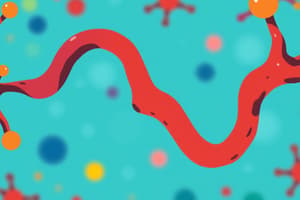Podcast
Questions and Answers
Which of the following is NOT a ventricle found in the human brain?
Which of the following is NOT a ventricle found in the human brain?
- Fifth Ventricle (correct)
- Left Lateral Ventricle
- Right Lateral Ventricle
- Fourth Ventricle
What is the main idea behind the theory of Equipotentiality?
What is the main idea behind the theory of Equipotentiality?
- The brain is a homogenous structure and all parts are equal in function.
- The brain is highly specialized, with different areas dedicated to specific functions.
- Different areas of the brain are solely responsible for specific cognitive functions.
- Different areas of the brain have the potential to take over the functions of damaged areas. (correct)
What is the purpose of trephination?
What is the purpose of trephination?
- To release pressure from the brain caused by a buildup of fluid or blood. (correct)
- To remove tumors from the brain.
- To access the ventricles of the brain for cerebrospinal fluid analysis.
- To study the function of different brain regions.
Which of the following statements best describes Golgi staining?
Which of the following statements best describes Golgi staining?
Which of these is NOT a key concept discussed in the lecture?
Which of these is NOT a key concept discussed in the lecture?
What characterizes LTD in synaptic transmission?
What characterizes LTD in synaptic transmission?
What happens to AMPA receptors when calcium enters due to NMDA receptor activation?
What happens to AMPA receptors when calcium enters due to NMDA receptor activation?
Which maze is specifically used to test spatial memory in rats?
Which maze is specifically used to test spatial memory in rats?
How is classical conditioning applied in immunology?
How is classical conditioning applied in immunology?
What defines learning in the context of behavior and experiences?
What defines learning in the context of behavior and experiences?
What is the role of calcium at the synaptic cleft?
What is the role of calcium at the synaptic cleft?
How does Botox affect neuromuscular junction (NMJ) function?
How does Botox affect neuromuscular junction (NMJ) function?
What primarily contributes to repolarization during an action potential?
What primarily contributes to repolarization during an action potential?
Which factor is NOT commonly known to affect susceptibility to neural damage?
Which factor is NOT commonly known to affect susceptibility to neural damage?
At which phase of the action potential do Na⁺ channels become inactivated?
At which phase of the action potential do Na⁺ channels become inactivated?
How does increased extracellular Na⁺ affect action potential amplitude?
How does increased extracellular Na⁺ affect action potential amplitude?
In Myasthenia Gravis, auto-antibodies target which part of the synaptic mechanism?
In Myasthenia Gravis, auto-antibodies target which part of the synaptic mechanism?
What role do K⁺ channels play during hyperpolarization?
What role do K⁺ channels play during hyperpolarization?
Which treatment option is used to increase the availability of acetylcholine in Myasthenia Gravis?
Which treatment option is used to increase the availability of acetylcholine in Myasthenia Gravis?
What is the primary effect of Tetanus toxin at the NMJ?
What is the primary effect of Tetanus toxin at the NMJ?
What effect do Na⁺ blockers have on action potentials?
What effect do Na⁺ blockers have on action potentials?
Which lifestyle factor is associated with increased susceptibility to neural damage?
Which lifestyle factor is associated with increased susceptibility to neural damage?
What occurs during the return to resting potential after an action potential?
What occurs during the return to resting potential after an action potential?
What interrupts the positive feedback loop of the action potential?
What interrupts the positive feedback loop of the action potential?
What defines the term 'potency' in a cellular context?
What defines the term 'potency' in a cellular context?
What happens to the action potential amplitude if extracellular K⁺ levels are increased?
What happens to the action potential amplitude if extracellular K⁺ levels are increased?
What is the primary function of the acetylcholine receptor?
What is the primary function of the acetylcholine receptor?
Which receptor primarily acts as an inhibitory receptor in the central nervous system?
Which receptor primarily acts as an inhibitory receptor in the central nervous system?
Which brain area is crucial for memory consolidation, particularly for spatial and declarative memory?
Which brain area is crucial for memory consolidation, particularly for spatial and declarative memory?
What differentiates local signaling from long-distance signaling?
What differentiates local signaling from long-distance signaling?
What role do agonists play in receptor activity?
What role do agonists play in receptor activity?
How do excitatory postsynaptic potentials (EPSPs) affect a neuron?
How do excitatory postsynaptic potentials (EPSPs) affect a neuron?
In which locations are inhibitory synapses most often found?
In which locations are inhibitory synapses most often found?
What is the difference between spatial summation and temporal summation?
What is the difference between spatial summation and temporal summation?
What initiates the release of neurotransmitters at the axon terminal?
What initiates the release of neurotransmitters at the axon terminal?
Which change in postsynaptic membrane potential is associated with an excitatory effect?
Which change in postsynaptic membrane potential is associated with an excitatory effect?
What is the primary action of benzodiazepines on GABA receptors?
What is the primary action of benzodiazepines on GABA receptors?
Which statement correctly describes long-term potentiation (LTP)?
Which statement correctly describes long-term potentiation (LTP)?
What distinguishes NMDA receptors from AMPA receptors?
What distinguishes NMDA receptors from AMPA receptors?
What happens when an action potential opens voltage-gated Ca²⁺ channels?
What happens when an action potential opens voltage-gated Ca²⁺ channels?
Which of the following statements about synaptic depression is correct?
Which of the following statements about synaptic depression is correct?
How does habituation differ from sensitization?
How does habituation differ from sensitization?
Flashcards
Trephination
Trephination
A surgical procedure that makes a hole in the skull.
Ventricles
Ventricles
Cavities in the brain producing and circulating cerebrospinal fluid (CSF).
Phrenology
Phrenology
The theory that skull bumps relate to mental abilities and character traits.
Equipotentiality
Equipotentiality
Signup and view all the flashcards
Golgi Staining
Golgi Staining
Signup and view all the flashcards
Action Potential (AP)
Action Potential (AP)
Signup and view all the flashcards
Voltage-Gated Na⁺ Channels
Voltage-Gated Na⁺ Channels
Signup and view all the flashcards
Repolarization
Repolarization
Signup and view all the flashcards
Voltage-Gated K⁺ Channels
Voltage-Gated K⁺ Channels
Signup and view all the flashcards
Ionic Basis of AP
Ionic Basis of AP
Signup and view all the flashcards
Positive Feedback Loop
Positive Feedback Loop
Signup and view all the flashcards
All-or-None Response
All-or-None Response
Signup and view all the flashcards
Effects of Ion Channel Blockers
Effects of Ion Channel Blockers
Signup and view all the flashcards
Susceptibility Factors
Susceptibility Factors
Signup and view all the flashcards
Genetic Vulnerability
Genetic Vulnerability
Signup and view all the flashcards
Calcium's Role in Synaptic Transmission
Calcium's Role in Synaptic Transmission
Signup and view all the flashcards
Botox Mechanism
Botox Mechanism
Signup and view all the flashcards
Tetanus Toxin Effect
Tetanus Toxin Effect
Signup and view all the flashcards
Myasthenia Gravis Symptoms
Myasthenia Gravis Symptoms
Signup and view all the flashcards
Auto-antibodies in Myasthenia Gravis
Auto-antibodies in Myasthenia Gravis
Signup and view all the flashcards
Affinity
Affinity
Signup and view all the flashcards
Long-Term Depression (LTD)
Long-Term Depression (LTD)
Signup and view all the flashcards
NMDA Receptor Activation
NMDA Receptor Activation
Signup and view all the flashcards
Calcium Entry Effects
Calcium Entry Effects
Signup and view all the flashcards
Spatial Learning Assays
Spatial Learning Assays
Signup and view all the flashcards
Classical Conditioning
Classical Conditioning
Signup and view all the flashcards
Acetylcholine Receptor
Acetylcholine Receptor
Signup and view all the flashcards
GABA Receptor
GABA Receptor
Signup and view all the flashcards
Hippocampus
Hippocampus
Signup and view all the flashcards
Local Signaling
Local Signaling
Signup and view all the flashcards
Long Distance Signaling
Long Distance Signaling
Signup and view all the flashcards
Agonist
Agonist
Signup and view all the flashcards
EPSP vs IPSP
EPSP vs IPSP
Signup and view all the flashcards
Spatial vs Temporal Summation
Spatial vs Temporal Summation
Signup and view all the flashcards
Transmitter Release Steps
Transmitter Release Steps
Signup and view all the flashcards
Types of Receptors and Effects
Types of Receptors and Effects
Signup and view all the flashcards
GABA Modulators
GABA Modulators
Signup and view all the flashcards
Calcium Influx Trigger
Calcium Influx Trigger
Signup and view all the flashcards
Procedural vs Declarative Memory
Procedural vs Declarative Memory
Signup and view all the flashcards
Conditioned vs Unconditioned Stimulus
Conditioned vs Unconditioned Stimulus
Signup and view all the flashcards
Sensitization vs Habituation
Sensitization vs Habituation
Signup and view all the flashcards
Study Notes
Definitions
- Affinity: The strength of a molecule's binding to another.
- Potency: The potential of a molecule to evoke a response.
- Agonist: A substance that binds to receptors, mimicking a neurotransmitter's action.
- Antagonist: A substance that blocks receptor activation by neurotransmitters.
- Ligand: A molecule that binds to a receptor, initiating a signal transduction pathway.
- Exogenous: Originating from outside the body.
- Endogenous: Originating from inside the body.
- Neurotransmitter: A chemical released by a neuron for communication with another.
- Neuromuscular junction: A specialized synapse where a motor neuron connects with a muscle fiber.
Concepts
- Local vs. Long-Distance signaling: Local: nearby cell communication; Long Distance: hormones.
- Agonist v. Antagonist: Agonist: activates a receptor; Antagonist: blocks it.
- Endogenous v. Exogenous ligands: Endogenous: naturally from the body; Exogenous: introduced from outside.
- EPSPs v. IPSPs: EPSPs (excitatory) depolarize, IPSPs (inhibitory) hyperpolarize.
- Spatial v. Temporal summation: Spatial: multiple signals combine at a single location, Temporal: signals from the same source are received close together.
Studying That Suits You
Use AI to generate personalized quizzes and flashcards to suit your learning preferences.




